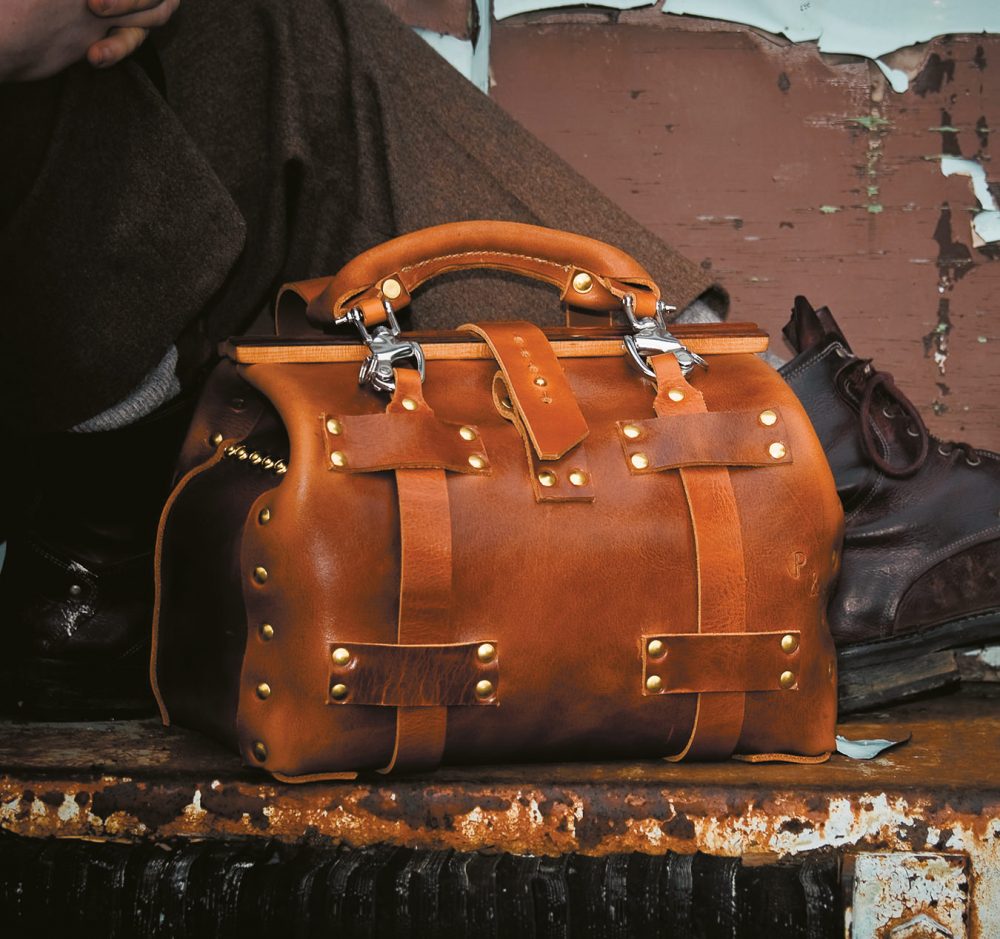Odds are that Nik Palmer will never be stranded on a desert island with nothing more than a pile of leather, but if he were, he wouldn’t require much to turn life’s lemons into leather bags. “I’d just need a punch, a knife, a mallet and a rivet,” he says, though that’s not to say the process is simple.
Along with his progeny Jack, Nik is Palmer and Sons, a two-year-old leather goods company that designs and hand-constructs suitcases, travel bags and cuffs using not much more than those desert island rations. Stroll into his corner of Octopus Studios, a shared artist space in Vancouver’s Downtown Eastside that he co-owns, and you’ll find the majority of his seemingly archaic tools stored in a makeshift leather bag the size of an ice cream bucket. “I must look like a medieval dentist,” he jokes.
While Nik has never removed molars, his path to bag-making is unconventional. Born in Middlesbrough, England, and a Vancouverite since 2002, he has been a chef, a computer game programmer and a carpenter in his 44 years. After observing a leather artist in his studio, Nik decided to try his hand at constructing a suitcase. He recalls, “My partner asked me, ‘Have you ever made a suitcase before?’ I said, ‘No, haven’t got a clue.’ ”
By deduction, Nik decided on his production methods. “I haven’t got a sewing machine, so I can’t use that. I don’t have a staple gun, so I can’t use that. And I don’t like using glue for anything. So I just put it together with what seemed sensible,” he says.
Each bag is built by one pair of hands from start to finish using quality materials, traditional implements and modern ingenuity. Pieces of leather—10 to 12 ounces of American bridle, Brazilian water buffalo or Italian cognac—are measured with a 1940s folding ruler and held together using solid brass rivets from Belgium. A file from a small worker-owned factory in France is used to shape the Cocobolo or Wenge hardwoods used on the handles of his best-selling Gladstone bag, a take on the portmanteau suitcase that became synonymous with four-time British prime minister William Ewart Gladstone.
Other signature details that set Palmer and Sons apart from the slew of other bag makers include shoulder straps on suitcases, equestrian panic straps and marine shackles. The industrial carabiners of high-rise workers also make for fascinating fasteners. The pièce de résistance, though, is the “P & S” insignia impressed into the leather with 70-year-old metal stamps sourced from India.
Using prototypes as guides, the Palmers look for unique characteristics in each piece of leather before measuring and cutting it with a carpet knife. One by one, holes are marked and punched, and rivets are pounded in with a wooden mallet and a rivet-setting anvil that is shared between father and son. With each bag requiring 120 to 180 rivets, this is the most time-consuming part of the process, clocking in at six hours. Wooden handles are sawed and filed (a nod to Nik’s days as a carpenter), hand-stitching is done if needed and fasteners are added before bags are treated with beeswax and branded. On average, each bag takes 16 to 20 hours to make, although Nik doesn’t keep track.
Production on the existing line doesn’t afford the Palmers much time for new designs, but they did recently complete a prototype for a men’s rucksack. A women’s rucksack and a bicycle bag are also in the works. As word spreads and orders grow, Nik acknowledges that they may have to modernize some of their assembly to meet demand. This won’t mean turning to machinery or outsourcing—rather, each step of the process will be assessed for predictability and economy of motion. Although he comes from the video game industry, where working on one small component of a large, lengthy project is common, he firmly believes in retaining heritage mores, saying, “There’s a lot of pride put into making something yourself from beginning to end.”









